Black Sea Shipyard: “Tbilisi” - “Admiral Kuznetsov”, completion and service of a heavy aircraft-carrying cruiser
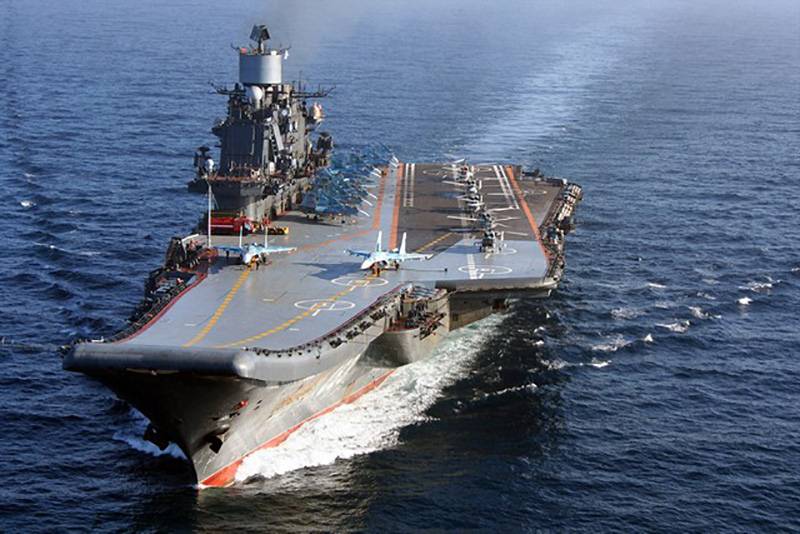
In addition, immediately after the launch of the 105 order, the next ship was laid down - the 106 order, which was inherited from Riga by its predecessor (these renames sometimes cause confusion). Thus, the Black Sea Plant conducted the construction of three heavy aircraft-carrying cruisers simultaneously, not counting civilian ships.
The completion of "Leonid Brezhnev" was complicated by the fact that it was necessary to manufacture and install a large number of head samples of special equipment and weapons. Simultaneously with the construction of "Leonid Brezhnev" intensive testing work was carried out on NITKA. There a wide stream of the latest and experimental equipment arrived. The installation of the first domestic aero-finisher Svetlana-23 took place, and in the summer of 1983, it began its tests for the development of aircraft braking. For this, the MiG-27 fighter was used first, and later the newest Su-27 and MiG-29KVP fighters, which performed braking after the runway runway.
In May, the 1984 of the year was carried out the first landing using an aero-finisher - first, the Su-27, and then the MiG-29, made the landing. Since August, 1984-th began the development of take-offs from the springboard, imitating a similar design of an aircraft carrier under construction. During these test flights, it was proved that it was possible in principle to take off without using a catapult from the deck of a heavy aircraft-carrying cruiser. To implement the training of pilots of the naval air group in Novofedorovka, the formation of the 100 training and instructor regiment began, and Su-27 and MiG-29 entered service.
In the meantime, the flywheel of the process called “perestroika” spun up in the Soviet Union, and in August the Leonid Brezhnev’s 1987 was apparently renamed Tbilisi as a result of the adjustment of the political course. The ship was still standing near the factory’s North Embankment of the Big Dipper, connected to shore power and communications. On the 105 order, thousands of workers, engineers, business trip specialists worked every day. For the convenience of access to the ship, the Chernomorsky plant designed, manufactured and installed a special escalator.
As it happened before, the construction of the ship was hampered not only by a large number of new equipment, but also by numerous disruptions in supplies from related companies. The project still made a variety of changes, changes and improvements. So, for example, to improve the design characteristics of the Polynom sonar station, whose function was to detect underwater targets, the Nevsky Design Bureau decided to change the design of the bulbous bulbous fairing. Since by that time “Tbilisi” had long been launched, it had to carry out an entire engineering operation.
Works of this kind were to be performed under dry-dock conditions, however, such a procedure would greatly delay the process of completion and, therefore, sea trials. A group of factory specialists developed their own solution: a specially designed and manufactured floating caisson was placed under the bulbous tip. And so all the work on reworking the fairing of the Polynom station was carried out by the plant.
By the end of 1987, the overall readiness of the heavy aircraft-carrying cruiser “Tbilisi” was estimated at 57% with a delay of about 15%, mainly due to the failure of equipment supplies. At the beginning of 1989, the installation of the main power plant was completed on the whole, and mooring trials began in June of that year. A number of weapons systems, such as, for example, modules of the Kortik complex, were not installed on the cruiser due to their absence.
In September, 1989, on the "Tbilisi" occurred the introduction of the crew. All this time the question of the quantitative and qualitative composition of the future naval air group remained a subject of unabated disputes and discussions. Both Su-27 and MiG-29 each had their own advantages and advantages. Then it was decided to conduct flight research tests directly at sea, without waiting for the final completion and fine-tuning of the ship.
October 21 1989 was actually unfinished and did not pass all the required tests "Tbilisi" left the Black Sea plant and accompanied by tugboats went into the Black Sea. On board was an incomplete crew, a large number of factory workers and contractors. A day later, the cruiser was already on the outer roads of Sevastopol.
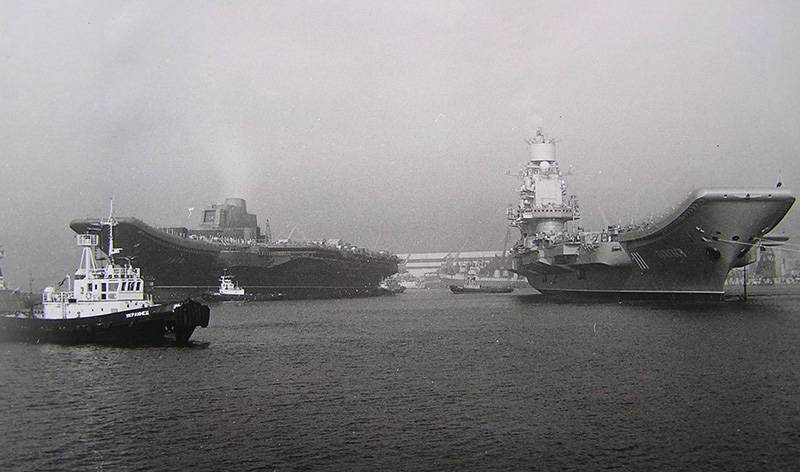
Began testing. The pilots made a roundabout of the Tbilisi-based, moving 10 – 13-node junction. October 28 1989 passed to the second stage: test pilots, Heroes of the Soviet Union Viktor Pugachev on the Su-27K and Toktar Aubakirov began to make flights over the deck, gradually reducing the height. On the same day, the aircraft were run without engagement with the arresting gear, followed by detachment from the deck and leaving upward with a left turn.
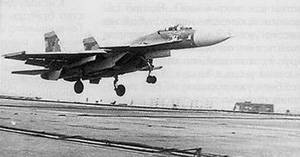
1 November 1989 of the year 13 hours 46 minutes Su-27K, piloted by test pilot Viktor Georgievich Pugachev, for the first time in stories domestic deck aviation made an aerofinishing landing on the deck of Tbilisi. Following him at 15 h. 11 min. A similar procedure was carried out by the MiG-29K Toktara Aubakirov. He at 16.48, for the first time using a springboard, lifted his car into the air. Following the fighters, the turn of the Su-25UTK attack aircraft came: piloted by test pilots Igor Votintsev and Alexander Krutov, the aircraft safely landed on the “aircraft carrier” at 17 hours 17 minutes. Flight design tests continued until November 20 - there were 35 landings on the cruiser.
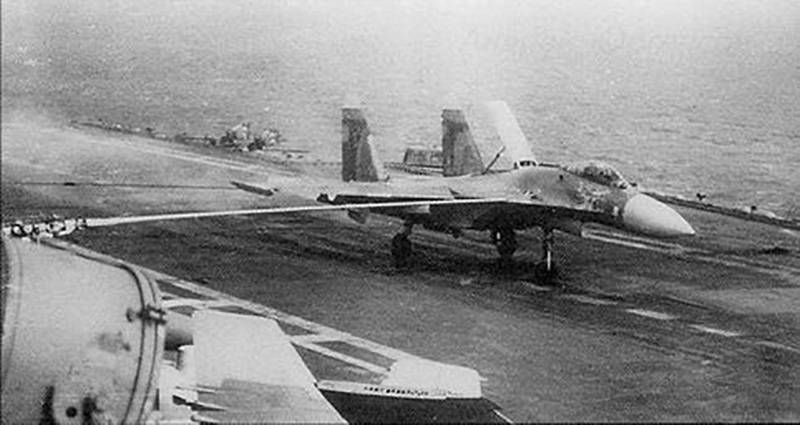
November 23 “Tbilisi” returned to the Black Sea plant for final finishing and completion. Part of the equipment and weapons was still missing, including the “late” modules of the “Dirks”. By the beginning of 1990, the cruiser’s readiness was estimated at 86%, and in April, preparations began for factory driving trials.
25 of May 1990 of the year “Tbilisi” left the water area of the Black Sea shipbuilding plant and went to Sevastopol to conduct sea trials. The complex of test trials was carried out in conjunction with flight tests of deck aircraft, which, apart from take-offs and landings, worked out the task of intercepting high-speed air targets and cruise missiles.
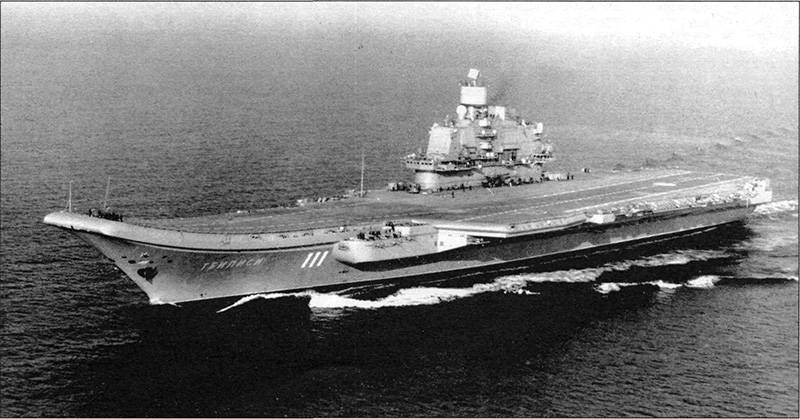
1 August 1990 began state tests, during which the ship was renamed again: 4 October 1990, he received a new, already the third in a row, the name "Admiral of the Fleet of the Soviet Union Kuznetsov" in honor of Nikolai Gerasimovich Kuznetsov, who advocated creating for the fleet USSR aircraft carriers. After completing the state testing cycle, the ship returned to the Black Sea Plant to eliminate the deficiencies. 25 December 1990, the signing of the acceptance certificate. In total, 8 years 3 of the month and 24 of the day passed from the moment of laying up to the ship's delivery. 29 January 1991, the Naval Flag was hoisted on it.
It was supposed to introduce a cruiser in the Northern Fleet. Transition to the North and combat service in the Mediterranean were scheduled for 1992 year, but for now Kuznetsov was in Sevastopol and occasionally went to sea for the ongoing intensive flight and design tests of fighters for the future ship group.
However, in terms of the further stay in the Black Sea basin of the heavy aircraft-carrying cruiser Admiral Kuznetsov, a rapidly changing political situation intervened. In the autumn of 1991, the huge power that created this complex unique ship began to crumble. Ukraine proclaimed its independence, December 1 should have been a presidential election. There was a completely unrealistic danger that Leonid Kravchuk (in the very recent past, the former secretary of the Central Committee of the Communist Party of Ukraine on ideology), who had every chance to take this position, could declare "Admiral Kuznetsov" the property of Ukraine. No one at that time had imagined that the division of the Black Sea Fleet would take a painfully long several years. In such a difficult situation, the Commander-in-Chief of the Navy, Admiral V.N.Chernavin, decided to urgently transfer the ship to its permanent location.
In the evening of December 1, a heavy aircraft-carrying cruiser standing on the roads of Sevastopol was ordered to anchor. At that time, on board were members of the guarantee team of the Black Sea Shipbuilding Plant and other enterprises, pilots and technicians of the 100-th Fighter Wing Aviation Regiment, who were serving with the ship to the North. The crew of the cruiser was understaffed.
In guarding the large anti-submarine ship Skory and the guard ship Immaculate, Admiral Kuznetsov moved in the direction of the Bosphorus. The Turkish Straits were passed without any obstacles from the Turkish side. In the Mediterranean, the ships of the 5-th operational squadron, which was in this region on a permanent basis, joined the escort of the cruiser. As Admiral Kuznetsov moved westward, the activity of NATO ships and aircraft, which showed genuine interest in the ship, increased.
Even in the Aegean Sea, the increased vibration of the third machine was found. The cause was discovered later; it turned out to be a fishing net, torn by a storm that wound on a screw. Subsequently, this obstacle was removed by divers. After the passage of Gibraltar, the ships of the Northern and Baltic fleets took up the baton to accompany the heavy aircraft-carrying cruiser.
December 20 "Admiral Kuznetsov" moored in Ura-Guba in the North. He was inducted into the 43 division of missile cruisers based in the village of Vidyaevo. Despite the special pontoon spacer manufactured by the Black Sea Shipyard with special equipment for basing ships in the North (mooring mechanisms and electrical equipment were installed on the pontoon), it was not easy to operate the ship in the base. Affected by the underdeveloped coastal infrastructure. The previously built heavy aircraft carrier “Kiev” has already encountered a similar problem. Kuznetsov also kept a constantly functioning machine-boiler installation or diesel generators.
From the autumn of 1992, the flight tests of deck aircraft continued - the aircraft-carrying cruiser periodically went out to sea for flight operations. By the way, the main flight crew of the 100 th Fighter Wing Aviation Regiment, headed by Colonel Timur Apakidze, refused to take the oath of Ukraine and left for the North. Timur Avtandilovich Apakidze, subsequently the Hero of Russia, made a huge contribution to the development of Russian carrier-based aircraft. In 2001, being already a major general, he tragically died during a demonstration flight.
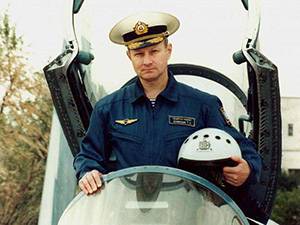
In 1993, despite the disastrous state of financing of the armed forces, the first production Su-33 fighters began to arrive at the Admiral Kuznetsov.
23 December 1995, the aircraft-carrying cruiser as part of a multi-purpose aircraft carrier group, which included the 1 destroyer, the 1 patrol ship, the nuclear submarine, the tanker and the tugboat, went to their first combat service in the Mediterranean Sea. Kuznetsov needed to repair the boilers, but the political situation demanded that Russian ships be located in this region. This campaign was intense: flights were carried out, various tasks were worked out. Were made visits to the Syrian port of Tartus and Maltese La Valletta.
During the campaign, “Admiral Kuznetsov” experienced considerable difficulties with the boilers, due to which it was necessary to reduce the speed to 10 – 12 nodes. 22 March 1996, the aircraft carrying cruiser returned to its permanent station in Vidyaevo. Soon he was put on medium repair at the Sevmorput enterprise, where with the help of seconded specialists from the Black Sea plant (technical cooperation at that stage of disintegration was still maintained) the machine-boiler group was thoroughly transferred. Repair, which was delayed due to lack of funding, continued until the summer of 1998, after which the ship returned to service.
In 1999, the Kuznetsov twice went into military service, and in 2000, he took part in large naval exercises, after which a campaign to the Mediterranean was planned. However, due to the tragic death of the nuclear submarine "Kursk" it was canceled. From 2001 to 2004, the cruiser underwent scheduled maintenance, after which it continued to serve. In the 2004, together with the nuclear-powered cruiser Peter the Great, the missile cruiser Marshal Ustinov and the destroyer Admiral Ushakov made a monthly voyage to the Atlantic.
From December 2007 to February 2008 of the year made a trip to the Mediterranean Sea together with a group of escort ships, after which the power plant was repaired and updated at the Zvezdochka plant. In the 2011 year - a hike to the shores of Syria. In subsequent years, the aircraft-carrying cruiser continued its service: in the 2015, its air group began to be replenished with new fighters MiG-29K and MiG-29CUB. From January to June, 2016 was repaired at the Sevmorput enterprise before the planned trip to the Mediterranean Sea.
Since November, 2016, as part of the operational connection of the far sea zone, for the first time took part in combat operations off the coast of Syria. The deck air group dealt attacks on personnel and equipment of the ISIL group (a terrorist organization banned in Russia). During the march that lasted until March 2017, the Admiral Kuznetsov traveled 18 thousand miles. One MiG-29K fighter was lost as a result of engine failure after November 14 2016 took off the year - the pilot ejected. December 5 crashed while landing the Su-33, and the plane crashed into the sea — the pilot also left the fighter’s cabin with a bailout.
After completing the campaign in the Mediterranean in the autumn of 2017, the Admiral Kuznetsov finally got up for overhaul at the 35-th ship repair plant in Roslyakov, which will last approximately until the 2020 of the year. The ship will not only undergo medium repair of the main power plant, but will also be thoroughly modernized. All these measures will extend the operation of a heavy aircraft-carrying cruiser for 20 years. The combat path of “Admiral Kuznetsov”, created at the Black Sea shipbuilding plant, will be continued. His later and technically advanced fellow less fortunate.
To be continued ...
Information